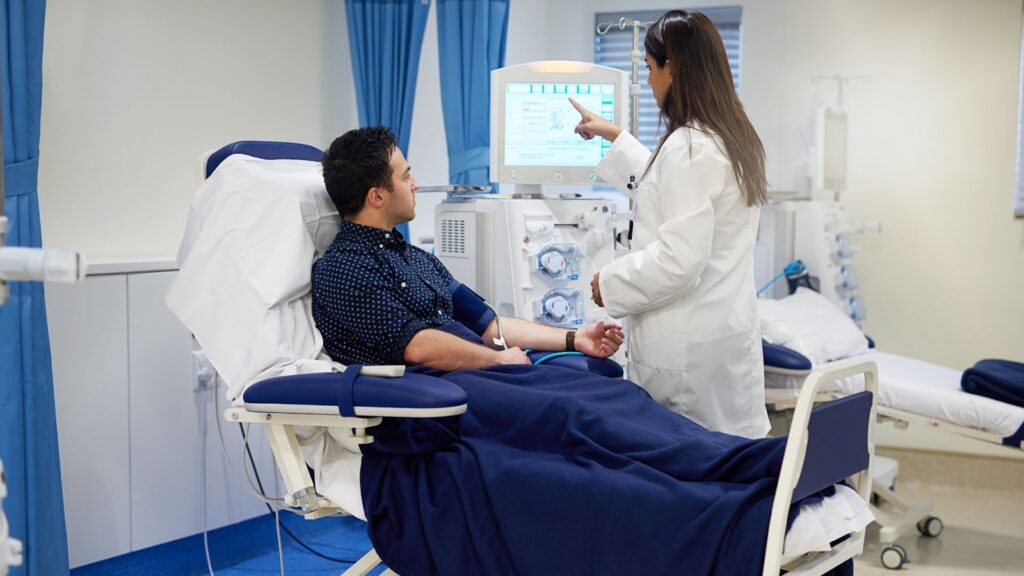Know About Dialysis Basics – How It Works and Who Needs It
10/06/2025
Imagine your body as a well-oiled machine, with the kidneys acting as its built-in filtration system. But what happens when this system fails? Kidney failure may cause a dangerous buildup of waste, excess fluids, and toxins in your body, leading to life-threatening complications. This is where dialysis treatment steps in as a lifesaving procedure that mimics the kidney’s function to remove waste products and excess fluid from your blood.
According to the National Kidney Foundation, over 500,000 people with kidney failure in the U.S. rely on dialysis to survive, and the Centers for Disease Control and Prevention (CDC) estimates that more than 35.5 million Americans suffer from chronic kidney disease (CKD). These statistics underscore the critical need for effective dialysis treatment options.
What is Dialysis?
Dialysis is a treatment that replaces the natural function of the kidneys when they can no longer filter waste and excess fluids effectively. This procedure helps maintain the body’s balance of fluids, electrolytes, and toxins.

Why is Dialysis Needed?
Dialysis may be needed when an individual develops end-stage kidney disease (ESKD) or chronic kidney disease (CKD). This occurs when kidney function remains below 10-15% of normal capacity, making it impossible for the kidneys to keep up with the body’s waste removal needs.
Other situations where dialysis may be required include:
- Acute kidney injury (AKI): A sudden loss of kidney function due to illness or injury.
- Severe fluid overload: When excess fluid from your blood cannot be naturally removed.
- Toxin buildup: High levels of waste and toxins can reach dangerous levels in the bloodstream.
Types of Dialysis
There are two main types of dialysis: hemodialysis and peritoneal dialysis. However, hemodialysis is the preferred choice for most patients due to its efficiency and effectiveness in filtering waste from the blood.
1. Hemodialysis (HD)
Hemodialysis information is essential for individuals considering this treatment. It involves removing blood from your body, filtering it through a dialysis machine, and returning the cleaned blood back into your body. A thin tube called a catheter or a surgically created vascular access (fistula or graft) is used to connect to the machine.
How Hemodialysis Works
- Blood is drawn out of the blood through a vein (usually in the arm or neck).
- It passes through an external dialysis machine where waste and excess fluids are filtered.
- The cleaned blood is returned back into your body.
- Each dialysis session usually takes about 3 to 5 hours and occurs 2 to 3 times per week at a dialysis center or home.
Where Hemodialysis is Done
- Dialysis center: Patients visit a hospital or dialysis unit several times a week.
- Home hemodialysis: A more flexible option allowing treatment at home.
2. Peritoneal Dialysis (PD)
Although hemodialysis is the preferred choice, some patients opt for peritoneal dialysis, a method that uses the lining of the abdomen (peritoneum) to filter waste.
How Peritoneal Dialysis Works
- A thin tube called a catheter is inserted into the peritoneal cavity.
- A special dialysis fluid is introduced into the abdomen, absorbing waste products and excess fluid.
- After a few hours, the fluid is drained and replaced with fresh dialysis fluid.
- Automated peritoneal dialysis (APD) can be done using a machine, often at night while sleeping.
While peritoneal dialysis can be done at home, home hemodialysis is generally preferred due to its more effective waste removal and ability to better control fluid levels.
Home Hemodialysis: A Convenient Option
With advances in medical technology, home dialysis may be an option for many individuals. Home hemodialysis provides greater flexibility and better health outcomes for those who qualify.
Benefits of Home Hemodialysis
- More frequent treatment sessions: Allows patients to dialyze 4 to 6 times per week, which can improve overall health.
- Better blood pressure control: Frequent sessions help prevent large fluid buildups.
- Improved quality of life: Patients have fewer dietary restrictions and more energy.
- Fewer hospital visits: Home dialysis reduces the risk of infections commonly found in dialysis centers.
Requirements for Home Hemodialysis
- A minor surgery is needed to create vascular access.
- Patients or caregivers must undergo training to learn about dialysis and how to operate the dialysis machine.
- A safe and sterile environment must be maintained at home.
Home dialysis is often covered by Medicare and many private insurance plans, including costs for training, equipment, and ongoing support. To learn more about coverage and eligibility, visit:
Insurance Coverage for Home Dialysis
Considering home hemodialysis? Talk to your healthcare provider to see if you’re a good candidate and understand how your insurance can support your treatment journey.
Who Needs Dialysis?
Many people on dialysis have kidney disease or kidney failure due to conditions such as:
- Diabetes: The leading cause of kidney failure. High blood sugar levels over time damage the kidneys’ filtering units, leading to permanent kidney damage.
- Hypertension (high blood pressure): Damages the small blood vessels in the kidneys, reducing their ability to filter waste effectively.
- Polycystic kidney disease (PKD): A genetic disorder that causes fluid-filled cysts to develop in the kidneys, leading to loss of function.
- Glomerulonephritis: Inflammation of kidney filtering units (glomeruli), which can cause scarring and reduce kidney efficiency.
- Severe kidney infections or blockages: Conditions such as repeated urinary tract infections or kidney stones can cause long-term kidney damage.
- Autoimmune diseases: Conditions like lupus and vasculitis can attack the kidneys, leading to kidney failure over time.
Dialysis Treatment Plan: What to Expect
When starting hemodialysis at home, a personalized treatment plan is developed with a healthcare provider. The plan includes:
- Frequency of treatment sessions based on kidney function and health status.
- Dialysis fluid and machine settings tailored to individual needs.
- Monitoring for complications, such as infection, clotting, or access failure.
- Regular blood tests to check kidney function and electrolyte balance.
- Adjustments to dialysis sessions as needed to optimize patient health and comfort.
Life on Dialysis: What Patients Should Know
Although dialysis performs the essential function of removing waste, it is not a cure for kidney disease. Patients must:
- Follow a kidney-friendly diet to prevent fluid and waste buildup, reducing strain on the body.
- Take prescribed medications to control blood pressure, prevent complications, and manage symptoms.
- Stay active and maintain a balanced lifestyle to improve overall well-being and reduce fatigue.
- Attend regular checkups to monitor kidney function, adjust treatment, and detect issues early.
- Maintain good vascular access care to prevent infections, clotting, or access failure.
- Stay hydrated while following fluid restrictions recommended by healthcare providers.
- Seek emotional support from support groups, counseling, or loved ones to cope with the challenges of dialysis.
- Monitor for potential complications, including infections, low blood pressure, or muscle cramps.
- Keep track of lab results to ensure the treatment plan is working effectively.
When to Talk to Your Doctor
Regular communication with your healthcare provider is essential for managing dialysis and your overall kidney health. Contact your doctor if you experience:
- Fluid Imbalance: Severe swelling (legs, feet, face), shortness of breath, or chest pain.
- Blood Pressure Issues: Dizziness, fainting, confusion (low blood pressure) or persistently high readings.
- Infection/Access Problems: Redness, warmth, swelling, pus, or unusual discharge at the access site.
- General Health Concerns: Persistent fatigue, frequent muscle cramps, severe pain, or significant changes in urine output.
- Abnormal Lab Results: Electrolyte imbalances or kidney function markers outside the target range.
- Other Symptoms: Mood changes, confusion, nausea, or unexplained weight fluctuations.
Remember, early intervention is key to preventing more serious complications. Keeping a symptom diary and recording any changes between dialysis sessions can be very helpful when discussing your condition with your doctor. Your healthcare team is there to support you, so don’t hesitate to reach out if you have any concerns about your treatment or overall health.
Frequently Asked Questions
Dialysis is a medical treatment that filters waste, excess fluids, and toxins from the blood when kidneys can’t function properly. It helps balance electrolytes, maintain blood pressure, and sustain overall health.
The “rule of 7” suggests dialysis patients should achieve a combined urea reduction ratio (URR) of at least 65–70% weekly, roughly equating to seven dialysis sessions per month for adequate clearance.
Dialysis works on three key principles: diffusion, osmosis, and ultrafiltration. These processes remove waste products, balance fluid levels, and correct electrolyte imbalances, essentially mimicking healthy kidney functions to maintain homeostasis in the body.
The five stages usually refer to chronic kidney disease progression: Stage 1 (mild damage), Stage 2 (mild reduction), Stage 3 (moderate), Stage 4 (severe), and Stage 5 (end-stage requiring dialysis or transplant)
The three main types are hemodialysis, peritoneal dialysis, and hemofiltration. Hemodialysis filters blood externally, peritoneal dialysis uses the abdominal lining, and hemofiltration removes waste with convective clearance techniques.
The “rule of 6” helps assess arteriovenous fistula maturity: vein diameter at least 6 mm, flow of 600 mL/min, depth within 6 mm, and usable within 6 weeks post-surgery.

Dr. Allen Kaufman is the Chief Medical Officer and Senior VP for Clinical & Scientific Affairs at Dialyze Direct, with over four decades of experience in Nephrology. He began his career in 1980 and has held leadership roles including Chief of Nephrology & Hypertension at Beth Israel Medical Center (1998–2004), Chief of Dialysis at the Bronx VA Medical Center (1982–1990), and Chief of the Yorkville Dialysis Unit at Beth Israel and the Renal Research Institute (1990–2000). Dr. Kaufman has authored over 100 scientific publications and served as Principal or Co-Investigator on numerous NIH-funded research studies. A Fellow of the American College of Physicians, he is board-certified in Nephrology and Internal Medicine. He earned his medical degree from the University of Rochester and completed training at the Hospital of the University of Pennsylvania and Mount Sinai in New York. Dr. Kaufman is widely recognized with multiple “Best Doctor” and “Patients’ Choice” awards.